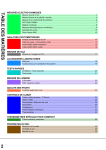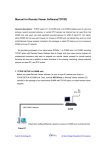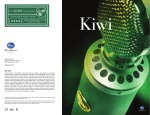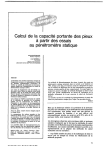Download Blue Microphones Kiwi Microphone User Manual
Transcript
Kiwi Kiwi C ongratulations on your purchase of the BLUE Kiwi, a premium large-diaphragm, multi-pattern condenser microphone made the old-fashioned way, without compromise. The Kiwi is a precision recording tool, combining the low noise and superb transient response of top-grade modern electronics with the crisp, airy high end magic of legendary vintage vocal mics. Among solid state microphones, the Kiwi is utterly unique; not only because of its size and styling, but also by virtue of its unprecedented range of nine different pickup patterns. In omnidirectional and figure of eight patterns, or at a distance, this microphone delivers every nuance in the room, with finely focused resolution and clear, musical frequency response out to the extremes of the audible spectrum. In its cardioid patterns the Kiwi excels at delivering a vocal or solo track right to the front of the mix where it belongs, with detailed highs, smooth midrange, and minimized proximity effect (a bass boost inherent in all unidirectional mics). At the heart of the Kiwi is a multi-pattern variation of the BLUE B6 Bottle microphone capsule. To provide matched response throughout the range of pickup patterns, two single backplate, large diaphragm capsules are acoustically matched, and then measured in our anechoic chamber for optimum performance. The end result is a hand-crafted dual backplate capsule, tuned to deliver a larger-than-life sound with extension in the lower and upper frequencies. Though designed primarily to achieve a world-class contemporary vocal sound, this capsule can be utilized to add a glossy, produced sheen to saxophone, piano, electric guitar, and other lead instruments. It also has extreme presence and “grab” at distances of three feet or more for distant acoustic guitar recording, ambient percussion miking, and unconventional vocal treatments. The microphone’s electronics are Class A discreet, with transformerless output. In plain English, this means that the sound which arrives at the diaphragm is transduced (converted to electrical energy) as accurately as possible, allowing the user to get the maximum benefit out of the multi-pattern capsule created by BLUE. To this end, the Kiwi utilizes hand-selected electronic components of the highest quality (such as expensive metal-film resistors), and there are no integrated circuits (a.k.a. “IC’s”), pads or low-cut filter switches in the signal path. In order to familiarize yourself with the specialized and unique features of the Kiwi microphone and accessories, please take the time to read this manual, and be sure to try the suggested recording tips. Getting Started The Kiwi system includes BLUE’s “The Shock” suspension mount, along with a padded, heirloom-quality wooden box which houses the microphone. “The Shock” is a vintage-style suspension mount designed to isolate the Kiwi microphone body from low frequency vibrations when mounted on a stand. To fit the Kiwi into this assembly, first open the wire latches on the upper and lower circular padded bands situated inside the shock mount frame. Then simply slide the Kiwi into the bands, make sure that the pattern selector switch is accessible, and close the wire latches to tighten the bands around the microphone. The angle of the mount assembly can be swiveled and adjusted with the large thumbscrew, which will normally be positioned at the rear of the mic. The Shock Once you have the Kiwi secured in the Shock, you may find it easiest to attach the assembly to a stand by 1) loosening the boom stand arm or threaded end of the mic stand, 2) grasping the mount assembly in one hand, and 3) screwing the mic stand threads into the mount, without over-tightening. This procedure will eliminate any possibility of damage to the mic. NOTE: Forceful positioning of The Shock without loosening of the thumbscrew can result in damage not covered by warranty. In order to get the most out of this, or any quality microphone, it is essential to pair it with a good microphone pre-amplifier. Most professional recordists prefer to have outboard preamps on hand, and will choose solid-state or vacuum tube models based on their unique characteristics. To maintain the integrity of your signal, use the BLUE Kiwi mic cable to connect the Kiwi to a mic preamp. Whenever possible, connect the mic preamp output directly to your recorder or A/D converter, bypassing the mixing board and any unnecessary components. The Kiwi requires 48 volt phantom power, which is provided by most mic preamps, mixing consoles, or separate phantom power supplies. It is important to note that some units, though rated at 48 volts, may supply insufficient or unstable phantom power, which can result in distortion and/or degraded performance when used with the Kiwi. To avoid damage to audio components when connecting phantom power, follow this simple procedure: 1) turn down the mic preamp gain, headphones, and your studio monitors, 2) connect microphone cable to the Kiwi and microphone input jack, 3) turn on phantom power, 4) turn up the mic preamp gain, etc. To disconnect or re-route the Kiwi, 1) turn down the mic preamp gain, headphones, and your studio monitors, 2) turn off phantom power and wait 10 seconds before disconnecting the mic. To secure the delicate capsule during transport and shipping, three brass set screws are provided. These screws should be mounted in the solid metal ring around the circumference of the grille when you first take the microphone out of its case. Remove these screws before using the microphone, and replace them if you will be transporting or shipping the microphone. NOTE: The Kiwi will not work properly if the security screws are not removed. Capsule and Pattern Characteristics When recording in a unidirectional pattern, the active, on-axis diaphragm is on the same side of the microphone as the BLUE logo. The pattern selector switch is located at the rear of the microphone, and is easily adjusted by hand, with no special tools required. In addition to the standard cardioid, omnidirectional, and figure of eight patterns marked on the selector switch, there are 6 intermediate gradations of sub-cardioid (between omni and cardioid) and super-cardioid (between cardioid and figure of eight) patterns to choose from. You will notice that the sound of the Kiwi capsule changes when adjustments are made to the nine-position pickup pattern switch on the microphone body. In general, the omnidirectional pattern offers the flattest frequency response, with an absence of proximity effect. As the pattern becomes more directional (by clicking clockwise through the switch settings, Kiwi Capsule Frequency Response Decibles (dB) 0 -4 -8 -12 20 30 50 70 100 200 300 500 800 2K 3K 5K 7K 10K 22.05K Frequency (Hz) This frequency chart of the Kiwi capsule is only a start. It gives the recordist a basis of the sound provided. How the microphone reacts in a particular application will differ greatly because of many variables. Room acoustics, distance from sound source (proximity), tuning of the instrument and microphone cabling are only a few of the interacting issues. For an artist or engineer, how the microphones are used creates the basis of the sound. towards the figure of eight position) bass frequencies increase proportionally due to proximity effect, and subtle changes also occur on the high end response. These shifts in overall timbre can be used to fine-tune the frequency response of the Kiwi, as well as for creative ends. Recording Applications Vocals Here’s a little-known secret— vocalists love singing into unique and impressive mics. And in addition to its classic styling, the Kiwi was developed especially to enhance the airiness and detail in a voice, while diminishing the proximity-induced lows which can cloud a mix or produce compression artifacts. Put it in front of any singer and you are guaranteed to get a 110% inspired performance that sits perfectly in the mix with little or no additional equalization. The Kiwi is also outstanding for narration and voice-over work. For a “big” vocal sound with maximum presence, get the vocalist within one to three inches of the capsule. There is no need to worry about overloading the microphone, but be sure to use the optional BLUE “The Pop” metal mesh pop filter to protect the diaphragm at close distances. Tilt the Kiwi up (toward the forehead) for more projection and head tone, straight on at the mouth for maximum brightness and intelligibility, or down toward the chest for more robust lows and smoother highs. Conventional vocal recording is almost always done using a cardioid pickup pattern. But the variable pattern control allows you to experiment with the timbre changes which occur in sub-cardioid (left of center on the pattern switch, towards omnidirectional) and super-cardioid (right of center, towards figure of eight) settings. The Pop Whenever possible, spend a few moments exploring these tonal shifts while “tuning” the pickup patterns. The figure of eight pattern is useful for recording two singers on one mic, or for a “hotter” solo vocal with increased proximity effect (i.e. a typical radio announcer voice). The omnidirectional pattern on the Kiwi can also be put to unique effect, whether recording a roomy, distant vocal track, capturing an unusual room ambience in combination with a close vocal mic, or on large group vocals. Acoustic Guitar For a balanced sound with plenty of sparkling high end, position the Kiwi facing the guitar neck, right where the neck joins the body (usually around the 12th– 14th frets). For starters, use the cardioid pattern, keep the capsule as close as possible, and angle it toward the sound hole to capture a blend of low end and pick sound. If you need more lows, move the capsule closer to the sound hole, or adjust the pickup pattern one click at a time toward the figure of eight position. For more high end detail, move the Kiwi farther from the guitar, either at the same neck position, or above the instrument up by the guitarist’s head. An omnidirectional pattern setting allows very close placement to the sound hole without boomy lows, and distant placement of three feet or more can produce interesting results throughout the available range of pickup patterns. Electric Guitar The Kiwi B6 capsule is useful for any clean amp sound, ranging from bright rhythm chords to warm jazzy tones. Angle the capsule toward the center of the speaker to capture more highs, or turn it toward the edge of the cone for a fuller sound with more low end. For overdriven or distorted tones, move the mic towards the outer edge of the cone, or back it away from the amp a foot or more to add a little room sound and soften the extreme high end. For even more control over definition and room tone on electric guitar tracks, it is common practice to use an ambient room mic in addition to a close mic on the amp. The omnidirectional or figure of eight patterns on the Kiwi are highly recommended for distant room miking applications on any amplified instruments, including bass, organ, and blues harmonica. 165x60 Dimensions (mm) 235x50x30 165x65 220x60 230x50x30 390x90 1700g 800g Power Supply 9610 880g 630g 980g 48V phantom powered 520g Weight Supply voltage 98dB 95dB 96dB 96dB Dyn. range of the mic amplifier 95dB 97dB 134dB 133dB 132dB 134dB Maximum SPL for THD 0.5% 133dB 130dB 7,5dB-A 8dB-A 7dB-A 10dB-A 87dB-A 87dB-A 8dB-A Noise level DIN/IEC 651 7dB-A 86dB-A S/N ratio DIN/IEC 651 87dB-A 82dB-A 87dB-A 76dB 71dB 76dB 76dB 76dB 75dB S/N ratio CCIR468-3 150ohms 150ohms 50ohms Not less than 1kohms 150ohms Rated load impedance 150ohms Rated impedance 20mV/Pa 18mV/Pa 19mV/Pa 21mV/Pa 21mV/Pa Cardioid Frequency range Directional Pattern Sensitivity at 1 kHz into 1 kohm 20mV/Pa multipattern 20Hz – 20KHz Cardioid Cardioid Cactus Kiwi Mouse Blueberry Technical Data Drums For kit and hand drums, begin by positioning the capsule two to four inches above the rim or hoop (where the head is secured to the shell). Angle the capsule toward the player’s stick or hand to pick up more attack and definition. Turning the capsule toward the shell will soften the sharp attack of a hand drum, or pick up more of the bright, crackling buzz from a Dragonfly Brass All members of the brass family need to be miked from in front of the bell. But for studio recording it is not necessary to aim the microphone capsule right down the center of the bore, or place it too close. The trumpet, with its directional characteristics, high sound pressure level, and limited frequency range, will yield a clear, cutting tone at distances ranging from 6 inches to 2 feet. The trombone and tuba can be approached similarly, although closer miking toward the outer edge of the bell (4 to 8 inches), and the enhanced proximity effect of supercardioid and figure of eight pickup patterns will help offset a thin or overly bright timbre. Capturing a mellow, rounded tone is a challenge with any brass instrument. To avoid buzzy highs and transient overloading, persuade the player to blow at less than peak stage volume. Cornet and flugelhorn usually have a softer, more intimate sound, are played at lower volume, and can be miked at a distance of 2 to 6 inches. Cardioid Bottle (w/B6) For other members of the saxophone family, start by placing the capsule two to six inches in front of the lip of the bell. Turn the capsule up toward the mouthpiece, or raise the microphone above the bell to capture more air, brightness, and high notes. For a mellower sound, rotating the microphone toward the floor emphasizes the low range of the sax, and tames the biting upper mids that project straight out of the bell, particularly on alto saxophone. Omnidirectional and subcardioid pickup patterns tend to soften the edge of close-miked saxophone tracks, while super-cardioid and figure of eight patterns emphasize high-end detail, cutting power, and warmth. 200ohms Percussion On tambourine, shaker, bells, clave, and orchestral percussion the Kiwi offers astounding clarity and realism, and can be positioned quite close to a percussive source without distortion or undue proximity effect. Start by placing the Kiwi about a foot from percussive instruments. Selecting a cardioid pickup pattern, or moving the mic closer to the source will emphasize detail and tone, as well as decreasing the proportion of ambient room sound on a track. More distant placement, or the use of an omnidirectional or figure of eight pattern will yield a natural, roomy sound that blends easily with other rhythm instruments. Pressure gradient Saxophones and Reeds For soprano sax, clarinet and related instruments, position the mic about a foot away, directly above and in front of the keys between the middle of the horn and the lowest pads. Try rotating the capsule or moving the mic up or down along the length of the body to adjust the balance of airy highs (toward the mouthpiece) and cutting midrange (toward the bell). The Kiwi will produce an interesting personality when used at a distance of four feet or more as an ambient room mic on drums. Many modern recordings have benefited from the unique sound of minimalist drum miking, where one to three microphones are strategically placed to capture the entire set, along with the characteristics of a well-tuned studio room. Acoustical operating principal Kiwi A less common, though very useful technique, is to position a stereo pair or single Kiwi microphone just outside of the piano, either in the curve of a grand, above an upright, or a few feet away for a classically-oriented sound with a significant amount of natural room reverberation. The variable pickup pattern control can be used to dial in the desired amount of ambience. snare. Moving the microphone closer to a drum generally increases the low end, shell resonance, and separation from other sound sources, while more distant placement emphasizes the interaction of the drum and the environment, producing a blended, airier sound. Microphones Piano Pop and jazz piano recording is usually accomplished with a pair of microphones placed inside a grand piano, either close to the hammers for a defined, percussive sound, or roughly in the middle of the piano body to get a more resonant and blended tone. When using these methods, it is conventional to employ a coincident stereo pair, with one microphone capsule oriented to pick up the treble strings, and the other focused on the bass range of the instrument. In keeping with our policy of continued product improvement, Baltic Latvian Universal Electronics (BLUE) reserves the right to alter specifications without prior notice. Classic microphones, made without compromise P.O. Box 910 Agoura Hills, CA 91376-0910 Phone 818.986.2583 Fax 818.784.7564 www.bluemic.com Warranty This Microphone or related part is warranted under the conditions outlined below to its original, registered owner, provided the purchase was made from an authorized Baltic Latvian Universal Electronics (BLUE) dealer. This Microphone or related part is guaranteed to remain free from operating defects for one year from the date of purchase. In the event that service is required, all necessary parts and labor will be furnished free of charge during this period except for tubes, which are guaranteed for 90 days against defects. This warranty is void if the serial number has been altered, removed or defaced. The warranty is void if the equipment is altered, misused, mishandled, maladjusted, or is serviced by any parties not authorized by Baltic Latvian Universal Electronics (BLUE). The warranty does not include transportation costs incurred because of the need for service unless arranged for in advance. Baltic Latvian Universal Electronics (BLUE) reserves the right to make changes in design and improve upon its products without obligation to install these improvements in any of its products previously manufactured. This warranty is in lieu of any or all expressed or implied.














